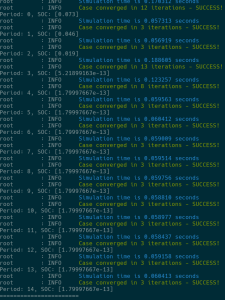Overall progress:
The webapp is showing continued improvement through better visuals and more charts.
The machine learning pipeline is further improved, with increased accuracy for load forecasting using a different ML method.
Optimization is not converging for some specific cases but showing correct behavior for partially charged operation. Validation and testing are still being performed on each period and the multi-period problem.
Significant risks and risk management:
Risk: Slow convergence of across multiple epochs
Description: The multi-period DDP algorithm is not converging over multiple periods due to oscillations through the back-propagation of the battery SOC equality constraint lambda.
Severity: The convergence issue means the algorithm takes too long to test effectively on different test cases and is a high-severity issue.
Resolution: To fix the underlying issue, I will analyze the behavior of the DDP using simple testcases and if no immediate solution is found, I will borrow existing known working DDP code.

